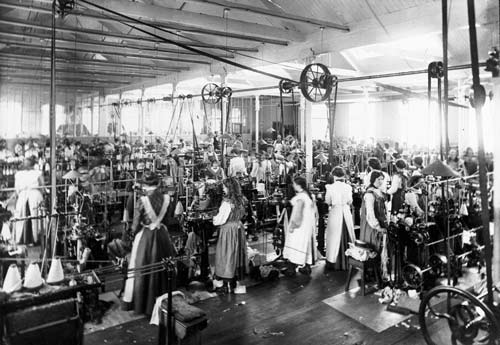What Were Some Of The Changes The Industrial Revolution Brought To The United States?
Inventions with speed and precision were congenital throughout the industrial revolution which led to the rise of the factories. Bigger machinery meant that the domestic system could no longer handle the demands of the manufacturing industry promoting the era of the mill.
New machines began to be invented from 1765 onwards that could spin many threads at one time. These inventions were the Spinning Jenny (1765) by James Hargreaves, Richard Arkwright'due south h2o frame (1769) and of grade Samuel Crompton'southward spinning mule (1779). This level of machinery couldn't be powered from the home every bit they used big water wheels.
Factories therefore with one big water wheel could comfortably powered all the equipment required and the demise of the domestic home and the ascent of the factories began.
The Textile industry was the starting time to adopt the factory as a place of piece of work and production of cotton wool and wool could be increased significantly. For those running the factories the industrial revolution was a profitable fourth dimension. Those working in the factories however had to put up with incredibly difficult working weather. Long hours, irregular breaks and labour intensive work fabricated the manufacturing plant lifestyle difficult. Even children were used throughout the factories equally workers. It was said that the rules were and then strict that even going to the toilet could only happen with permission from the bosses.
Children were perhaps the biggest victims of the factory boom as they were seen as nifty options within the workplace. The combination of cheap labour, easily replaceable if accidents occurred (Children from Orphanages in particular) and they were small-scale enough to crawl under machines to tie up broken threads. The safeguarding of children in item was not existent.
This began to be pondered in 1820 as to whether this was off-white and in 183 a legislation was implemented known as the 'Factory act which prevented children from under the age of ix from working inside the factories. A small victory possibly but still an extremely young age for working in such challenging atmospheric condition.
Although Children were by and large at hazard in that location were still day to mean solar day risks for adults also as ultimately Factories were ran with profit in mind. Wellness and safety was non existent and no factory uniform. With the machines defective whatever protective guarding it wasn't uncommon for clothes to be caught within machines and accidents to happen. Of course this didn't matter for the manufactory owners. They were running for huge profits and but interested in increasing production and maximising the money they earned.
Richard Arkwrigh t 1 of the most well known factory owners of the industrial revolution was perhaps one of the caring owners of the era. Although his day to twenty-four hours rules were yet very much strict in nature he did build homes, churches and provide bones education to the children of families who worked within the factories.
Arkwright however was one of very few who did this. Most saw the mill as a job for their workers; one of which they should be eternally grateful for. Conditions would remain the same for these workers considering they had a task and equally far as the manufacturing plant owners saw it they were there to work.
There were many slap-up inventions inside the rise of the factories and the speed of these new spinning machines meant that weavers were struggling to keep up. In 1787 the power loom was created and by 1829 there were 49,000 of these throughout factories all over U.k. with one worker operating four of these at one fourth dimension! It was a mind blowing operation.
The rise of the factories came with both positives and negatives ultimately to the people of Britain. Economy wise the land got a huge heave and the factories brought people from across the country together, working side by side. Furthermore the pressure for finding food and keeping your family from going hungry passed as manufactory piece of work provided plenty financially to get by,
The negatives of this were the factory life in general. Long hours working in extremely poor working conditions and been presented with injury run a risk everyday. The factories weren't great places to work nonetheless through the years we would come across this proceed to get better and meliorate bringing us to the high standards most factories operate today.
Source: https://industrialrevolution.org.uk/factories-industrial-revolution/
Posted by: lamoureuxtheatanthe.blogspot.com


0 Response to "What Were Some Of The Changes The Industrial Revolution Brought To The United States?"
Post a Comment